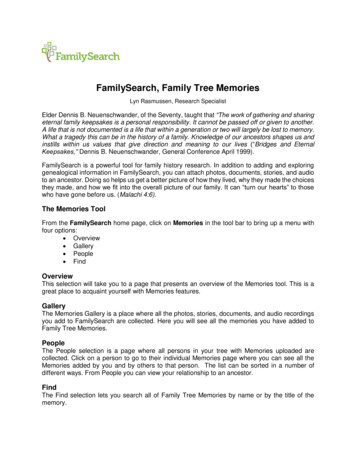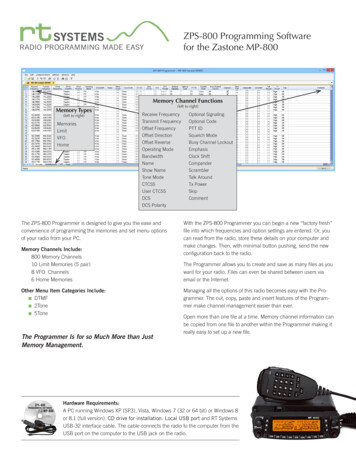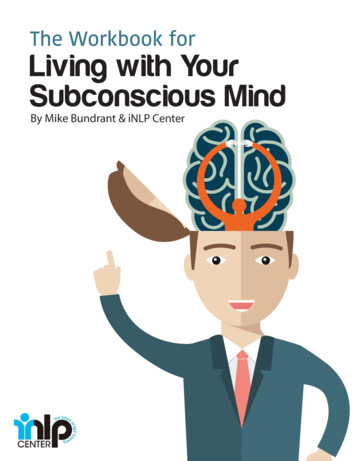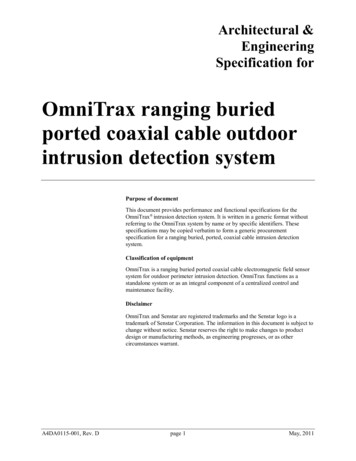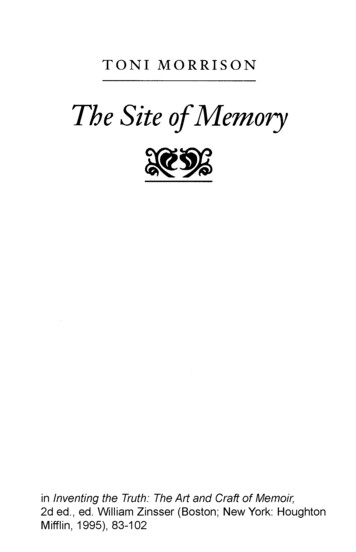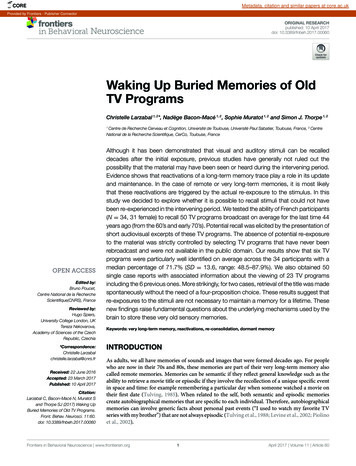
Transcription
COREMetadata, citation and similar papers at core.ac.ukProvided by Frontiers - Publisher ConnectorORIGINAL RESEARCHpublished: 10 April 2017doi: 10.3389/fnbeh.2017.00060Waking Up Buried Memories of OldTV ProgramsChristelle Larzabal 1, 2*, Nadège Bacon-Macé 1, 2 , Sophie Muratot 1, 2 and Simon J. Thorpe 1, 21Centre de Recherche Cerveau et Cognition, Université de Toulouse, Université Paul Sabatier, Toulouse, France, 2 CentreNational de la Recherche Scientifique, CerCo, Toulouse, FranceEdited by:Bruno Poucet,Centre National de la RechercheScientifique(CNRS), FranceReviewed by:Hugo Spiers,University College London, UKTereza Nekovarova,Academy of Sciences of the CzechRepublic, Czechia*Correspondence:Christelle Larzabalchristelle.larzabal@cnrs.frReceived: 22 June 2016Accepted: 23 March 2017Published: 10 April 2017Citation:Larzabal C, Bacon-Macé N, Muratot Sand Thorpe SJ (2017) Waking UpBuried Memories of Old TV Programs.Front. Behav. Neurosci. 11:60.doi: 10.3389/fnbeh.2017.00060Although it has been demonstrated that visual and auditory stimuli can be recalleddecades after the initial exposure, previous studies have generally not ruled out thepossibility that the material may have been seen or heard during the intervening period.Evidence shows that reactivations of a long-term memory trace play a role in its updateand maintenance. In the case of remote or very long-term memories, it is most likelythat these reactivations are triggered by the actual re-exposure to the stimulus. In thisstudy we decided to explore whether it is possible to recall stimuli that could not havebeen re-experienced in the intervening period. We tested the ability of French participants(N 34, 31 female) to recall 50 TV programs broadcast on average for the last time 44years ago (from the 60’s and early 70’s). Potential recall was elicited by the presentation ofshort audiovisual excerpts of these TV programs. The absence of potential re-exposureto the material was strictly controlled by selecting TV programs that have never beenrebroadcast and were not available in the public domain. Our results show that six TVprograms were particularly well identified on average across the 34 participants with amedian percentage of 71.7% (SD 13.6, range: 48.5–87.9%). We also obtained 50single case reports with associated information about the viewing of 23 TV programsincluding the 6 previous ones. More strikingly, for two cases, retrieval of the title was madespontaneously without the need of a four-proposition choice. These results suggest thatre-exposures to the stimuli are not necessary to maintain a memory for a lifetime. Thesenew findings raise fundamental questions about the underlying mechanisms used by thebrain to store these very old sensory memories.Keywords: very long-term memory, reactivations, re-consolidation, dormant memoryINTRODUCTIONAs adults, we all have memories of sounds and images that were formed decades ago. For peoplewho are now in their 70s and 80s, these memories are part of their very long-term memory alsocalled remote memories. Memories can be semantic if they reflect general knowledge such as theability to retrieve a movie title or episodic if they involve the recollection of a unique specific eventin space and time: for example remembering a particular day when someone watched a movie ontheir first date (Tulving, 1985). When related to the self, both semantic and episodic memoriescreate autobiographical memories that are specific to each individual. Therefore, autobiographicalmemories can involve generic facts about personal past events (“I used to watch my favorite TVseries with my brother”) that are not always episodic (Tulving et al., 1988; Levine et al., 2002; Piolinoet al., 2002).Frontiers in Behavioral Neuroscience www.frontiersin.org1April 2017 Volume 11 Article 60
Larzabal et al.Waking Up Buried Memoriesmore accessible and are less vulnerable to decay (Gisquet-Verrierand Riccio, 2012). Accordingly, it might be natural to thinkthat remote memories could be maintained via subsequent reconsolidations that are triggered by specific stimuli, even if thesere- consolidations are scattered in time. This leaves open thequestion of whether it is possible to retrieve very long-termmemories for stimuli that have not been re-experienced fordecades and that are left in a dormant state in the absence of anysubsequent reactivations.In this study we tested the ability of French people to recalla selected set of 50 TV programs that were originally broadcastwith between 6 and 120 episodes between the late 50’s andearly 70’s. These TV programs have never been rebroadcast andare not available in the public domain so we can be certainthat the stimuli have not been seen or heard since the originalbroadcast. Furthermore, the participants reported that they hadnot thought about them for years, making it unlikely that theywould have involuntarily reactivated the memories (Rasmussenand Berntsen, 2009).By sorting participants performance over the confidence intheir response, we found 6 TV programs with a percentageof correct identification (median: 71.7%, SD 13.6, range:48.5–87.9%) that was significantly higher than for youngerparticipants. Interestingly, these 6 TV programs were part ofa set of 23 videos for which we collected single case reportswith associated information about the viewing at the time ofbroadcast. Whereas, identification was mainly performed byselecting the correct title from four propositions, in two cases, thepresentation of short excerpts of old opening themes was able totrigger spontaneous naming of the title. Overall our data suggeststhat visual and auditory memories can indeed be retrieved evenwhen they have been buried for decades.Important neuronal reorganizations are required to createlong-lasting memories and involve two consolidation stages(Frankland and Bontempi, 2005). The first one which is calledsynaptic consolidation refers to the stabilization of synapticweights of a new memory in localized networks. This process isfast and can be completed within a few hours after learning. Thesecond one, involving system-level consolidation, is much slowerand corresponds to a change of brain regions that support thememory. Both the hippocampus and the neocortical structuresare initially involved in supporting declarative memories(semantic and episodic memories). However, within severalmonths after learning, theories suggest that declarative memoriesmight become independent of the hippocampus. This wouldconcern semantic and episodic memories in light of the so-calledstandard model (Squire and Alvarez, 1995) or simply semanticinformation regarding the Multiple Trace Theory (Nadel andMoscovitch, 1997). Note that the debate is still not closed betweenthese two theories.Given the practical difficulties involved, only a small numberof studies have tried to test recall decades after the acquisitionphase. Such studies have looked at memories concerning oldclassmates (Bahrick et al., 1975), information learnt in school(Bahrick, 1984; Conway et al., 1991), or even TV programs(Squire and Slater, 1975; Squire and Fox, 1980; Squire, 1989).Although the stimuli used are different, the results follow thesame trend: recall drops quickly over the first 6 years and thenlevels off for several decades.As mentioned by the authors, in such studies, one parameterthat is hard to control fully is potential reactivations of theinformation during the intervening period which might explainthe extremely long retention of these memories. It has beenshown that memory reactivations can be triggered spontaneouslyduring periods when the processing of sensory input is very low(“off-line states”) such as during sleep (Wilson and McNaughton,1994; Peigneux et al., 2004; Diekelmann and Born, 2010) orwakefulness (Foster and Wilson, 2006; Peigneux et al., 2006;Karlsson and Frank, 2009; Oudiette et al., 2013) as well as during“on-line states” when subjects are actively retrieving memories(Nyberg et al., 2000; Gelbard-Sagiv et al., 2008; Tayler et al.,2013). While reactivations during “off-line states” are criticalfor the consolidation of a new memory (Gais et al., 2000;Girardeau et al., 2009) and are very frequent in the first fewhours after learning (Ribeiro et al., 2004; Eschenko et al., 2008),their probability of occurrence is likely to decrease exponentiallyover time (McClelland et al., 1995; Frankland and Bontempi,2005), leaving the memory in a dormant state (Lewis, 1979;Sara, 2000; Dudai, 2004). This suggests that the reactivation ofthese dormant or inactive memories might occur spontaneously,especially during “on-line” states when sensory input is strongenough to elicit memory retrieval, that is, during the re-exposureto the stimulus or when it is mentally evoked. For about 15years now and since the discovery of Nader et al. (2000) ithas been shown that reactivations of stable and consolidatedmemories through specific stimulus re-exposure might triggerre-consolidation processes. During this temporary unstable stage,memory traces are updated (Dudai, 2006) and strengthened(Moscovitch et al., 2006; Lee, 2008) and as a result, becomeFrontiers in Behavioral Neuroscience www.frontiersin.orgMATERIALS AND METHODSParticipantsThirty four subjects, all French (31 female; range 52–92years, median age 77 years, mean age 79 years, SD 7.6) with normal or corrected-to-normal vision and auditionparticipated in the study. All of these participants were recruitedand tested individually in senior citizen clubs. Before startingthe experiment participants were invited to respond to aquestionnaire to give personal details about their TV habits.They were asked to say roughly when their household first had atelevision and how many hours a day they typically watched TVat the time of the test (Table S1). The participants reported firsthaving a television sometime between 1956 and 1970 with half ofthem having access to a television before 1964 (SD 4.1) and saidthat they currently were watching TV for an average of 3.5 h a day(range 0.5–9 h, SD 2.1). After the experiment, participants gavetheir feedback about the TV programs they were able to recall.None of them reported thinking about the ones which had neverbeen rebroadcast. The overall cognitive abilities of 25 out of the34 older participants were also assessed using the Mini-MentalState Examination (MMSE) (Folstein et al., 1975) based on theFrench GRECO consensual version. No main deficit was found2April 2017 Volume 11 Article 60
Larzabal et al.Waking Up Buried Memoriesprogram? and (5) Give as much information as you can about thisTV program (e.g.,: Who did you usually watch this TV programwith? Have you watched a lot of episodes? What details could yougive about the characters? etc.). Short breaks were made every 10trials. The experiment lasted about 1 h and was programmed withPsychopy (Peirce, 2007).In addition to the 34 participants tested, 34 youngerparticipants performed the same task to make sure that the fourtitles proposed in the 4-FC would have the same probability ofbeing chosen by naïve subjects who could only rely on semanticinformation to make their choice. Although it would have beenpossible to use age-matched controls, this was not the case here.We chose to test younger participants so that we could be certainthat all the test videos were new to them. This would have beenmore difficult to control for older participants even if they saidthat they did not have a TV set in their house during that period,because at that time, it was relatively common to watch TV insomeone else’s home.for any of the participants (mean score 27.6 out of 30, SD 1.9,range: 24–30).Thirty-four younger participants, [t (66) 32.0, p 0.001],all French (23 female; range 21–40 years, median age 26years, mean age 27 years, SD 5.5) with normal or correctedto-normal vision and audition participated in the same study.Younger participants reported having access to a TV set frombetween 1976 and 1999 (mean year 1992, SD 5.9) andwatching TV for 1.2 h a day (range 0–5 h, SD 1.5).StimuliAudiovisual clips (size: 640 480) were presented on a graybackground at the center of a laptop screen placed in front ofthe participant (Hewlett Packard EliteBook, screen resolution:1,366 768). The clips used a 1 s count-down followed by a 7 sopening theme of a TV program. The clips generally displayedthe first 7 s of the opening themes without any text. In total72 audiovisual clips were shown to each participant. Fifty ofthe clips were test videos that were composed of the openingtheme excerpts of French TV programs which had never beenrebroadcast and were not available in the public domain. Withsupport from the French Audiovisual National Institute (INA),the videos were collected directly from an up-to-date databasewhich has been collecting information on audiovisual programsbroadcast since 1947. Videos were selected because they seemedoriginal and because they did not change from the first to thelast episode. The number of episodes was known for 36 of the 50clips, and ranged from a minimum of 6 episodes to a maximumof 120, with a mean of 23.7. One of the programs was broadcastin the late 50’s, 30 in the 60’s and 19 were first broadcast in the70’s. The average year of the last episode broadcast was 1970. Theremaining 22 clips were famous videos of the opening themes ofwell-known TV programs which in some cases were still on airand were not necessarily French (Table S2). They were supposedto be easy to recognize and to keep participants’ interest duringthe task.RESULTSParticipants’ Performance for the FamousTV ProgramsDuring the presentation of the audiovisual clips or after theirdisplay, participants were first invited to decide whether the TVprogram was familiar or not. The older participants reported thatthey were familiar with 56.5% (SD 24.8) of the 22 famousaudiovisual clips that were presented.When participants said that a video was familiar, they wereinvited to name the title of the TV program directly (free titlenaming). On average, each famous video was spontaneously andcorrectly named by nine out of 34 older participants (27.5%,SD 19.4, range 0–25). This shows that the free namingof a title was high for the 22 famous TV programs and wasalways associated with a high confidence level (average 4.5up to 5, SD 0.5). Overall, a median number of 6 (SD 4.3)famous videos were correctly named spontaneously by the olderparticipants, which was significantly lower than the 12 (SD 4.9)correct titles reported spontaneously by the younger participantsfor the same famous videos (Wilcoxon signed-rank test: Z 4.18, p 0.001).If participants found that it was too difficult to retrieve atitle spontaneously, they were asked to select a title from fourpropositions (4-FC). When the older participants reported thatthey were familiar with the famous TV programs, the percentageof correct responses in the 4-FC was high (86.6%, SD 21.7)and was not different from the younger participants (91.5%,SD 14.9). The 4-FC was also directly proposed to the olderparticipants who said that a video was not familiar. Overall, 68.8%(SD 20.0) of the responses for famous clips were collectedusing the 4-FC including both familiar and unfamiliar responses.The older participants’ performance was high when they hadto choose the title of famous audiovisual clips (74.7%, SD 15.5) and was not different from the younger participants (72.8%,SD 12.9).Interestingly, we found that the average percentage ofidentification for the famous videos was significantly correlatedTaskThe experiment involved 72 trials with each video clip beingpresented only once. Each trial started with the presentation ofan 8-s video clip (Figure 1). During the video or after its display,participants’ recall responses were collected as follows: (1) Doesthis TV program look familiar to you (Yes/No)? (2) If yes, canyou name the title of this TV program? (Free title naming). Ifnot, please choose the related-title from the four propositionsin the forced-choice (4-FC). The four propositions included thecorrect title, a lure (title of another TV program) and two foils(fabricated titles). The lures and foils were selected to be asplausible as possible. Propositions were displayed in alphabeticalorder. (3) Rate your confidence in your response on a five-pointscale (1: “Not sure at all”; 2: “A bit sure”; 3: “Fairly sure”; 4:“Very sure”; 5: “Completely sure”). Five questions were also askedwhen participants reported being familiar with the TV programin order to get associated information: (1) What day(s) of theweek did you watch this TV program? (2) Around what timeof the day: in the morning, in the afternoon or in the evening?(3) How old were you at that time? (4) Did you like this TVFrontiers in Behavioral Neuroscience www.frontiersin.org3April 2017 Volume 11 Article 60
Larzabal et al.Waking Up Buried MemoriesFIGURE 1 Experimental design. Audiovisual clips of the TV programs were shown on a computer screen. Participants decided whether the program was familiarby using a button press response. If familiar, participants attempted to give the title by free naming. Alternatively, they were given a four-proposition forced-choice(4-FC). The confidence level in the response was assessed on a five-point scale. For the familiar videos, five questions were asked to get associated information aboutthe TV program.Older Participants’ Performance for theTest TV Programswith the older participants’ average confidence on the response (r 0.71, p 0.001, Pearson’s linear correlation coefficient). Thesame effect was found in the younger participants (r 0.79, p 0.001, Pearson’s linear correlation coefficient).Overall, the older participants’ performance was high for the22 famous videos (median 81.8%, SD 9.7, range: 54.5–95.4%) showing that they could correctly perform the task.However, with a median of 90.9% (SD 9.1, range: 54.5–95.4%) the younger participants’ performance on the samevideos was even better (Wilcoxon signed-rank test: Z 3.37,p 0.001). Such high levels of performance are explainedby the fact that these famous TV programs are still verypresent in the media or even on TV. To what extent arethe older participants able to identify old TV programs thathave not been re-experienced for decades? We now addressthis question.Frontiers in Behavioral Neuroscience www.frontiersin.orgSingle Case Reports for Familiar Test VideosOn average, the older participants reported that they werefamiliar with 15.2% (SD 13.1) of the test videos.Free title naming for test videosFrom the 50 test videos presented to 34 older participants, thetitles of two TV programs were spontaneously recalled (free titlenaming). Although this percentage is very small (0.1%) it is stillabove the null score obtained by the 34 younger participants thatwere expected not to know the TV programs. Interestingly, thesetwo free title namings were associated with a medium/high levelof confidence in addition to associated information about theTV program. The following is a detailed description of the tworesponses:4April 2017 Volume 11 Article 60
Larzabal et al.Waking Up Buried Memorieswith free namings are given in the Table 1. Here are a fewexamples:Report 8 (Table 1): After the presentation of the TV program“Poker d’as,” participant 13 (Table S1) reported that she wasfamiliar with the TV program and chose the correct title on the4-FC with a confidence rate of 2 out of 5 (“a bit sure,” averageconfidence for all test TV programs: 1.3, SD 0.4). Then shereported that she liked the TV program and watched it duringthe week, in the evening, when she was 30–35. She added that sheused to watch it with her husband but without the children andremembered having seen several episodes.Actual facts: “Poker d’as” was a one-season TV series of 26episodes broadcast in 1973 from Monday to Friday at 8 p.m. Theparticipant was 37 at that time and was 78 when tested.Report 46 (Table 1): Participant 16 (Table S1) reported shewas familiar with “Animal Parade” and correctly identified it inthe 4-FC. Her confidence rate was 3 (“medium sure,” averageconfidence for the 50 test TV programs: 1.4, SD 0.8). Thenshe reported watching it during the week and at weekends inthe afternoon. She could not remember how old she was at thetime but she remembered that she liked it and watched it withher children.Actual facts: “Animal Parade” was a single-season youth TVprogram broadcast from the 14th to the 25th of February (weekand weekend) in 1972 at 7.30 p.m.Report 45 (Table 1) is interesting because of the 21 famousand test videos considered as familiar by participant 7 (Table S1),she reported that there were only two TV programs she did notlike: “30 millions d’amis” an animal TV magazine and “Que feraitdonc Faber?,” a comedy series broadcast in 1969. We found thatthere had been a large controversy following the broadcast of“Que ferait donc Faber?” with a lot of criticism from the Frenchnewspapers and the viewers. Other details reported by participant7 (who was 91 when tested) and in particular the day and time ofbroadcast or her age matched the actual facts.Among the 34 participants that were recruited we had theopportunity to test a couple individually on the same day:participants 25 and 30 (Table S1) who have had a TV set since1964. Interestingly, participant 25 reported being familiar with“Poker d’as” and chose the correct title in the 4-FC with aconfidence rate of two (“a bit sure,” average confidence for the50 test TV programs: 1.0, SD 0.1). He said that he used towatch it on weekdays during the evening when he was fifty. Headded that he liked the TV program and watched it with hisfamily but not too often. This was when they were still in Tarnet-Garonne (a department in the South of France) a bit before1976 so when he was 36 (report 7, Table 1). Interestingly byrecollecting this last piece of information, participant 7 correctedhimself concerning his age at the time of broadcast. And indeed,this TV program was broadcast on weekdays at 8 p.m. in 1976when he was 33. Unlike her husband participant 30 did notreport any familiarity with “Poker d’as” but picked the correcttitle from the 4-FC with a confidence rate of 3 out of 5 (“mediumsure,” average confidence for the 50 test TV programs: 1.5, SD 0.7).A detailed analysis of the older participants’ performanceshows that the number of famous and test TV programs forOn the first free recall, participant 5 (Table S1) said “Balzac,”which was close to the correct title “Un grand amour de Balzac.”Her confidence level was 3 out of 5. She was then asked togive details about her memories: “I was watching it on Saturdayafternoon. I was sixty. Yes I’ve always loved sentimental andhistorical TV serials. I remember cousin Bette. I watched a lotof episodes.”Actual facts: Episodes were broadcast in 1973 (she was 49years-old, she is now 90) every Thursday at 9 p.m. Seven episodesof 52 min were screened.The other participant, participant 22 (Table S1) said“Camember” for “Les facéties du sapeur Camember,” with aconfidence response at 4 out of 5.The participant then reported: “I used to watch it on Sundayevening. I was 35. I liked it but I did not watch it too often. Thewhole family used to watch it.”Actual facts: Episodes were broadcast in 1965 (he was 28 yearsold, he is now 77), every day, except on Sunday. The TV programhad 50 episodes lasting 5 min each. Initially the program startedat 8.30 p.m. but switched to 9 p.m. from the 20th episode.4-FC for familiar test videosWhen participants reported to be familiar with a TV programbut could not name it spontaneously they were asked to selecta title from four propositions (4-FC). Overall the percentage ofresponses was 23.7% (SD 24.8) for the correct titles, 43.8%(SD 27.2) for the lures and 14.6% (SD 16.7) and 17.9%(SD 16.1) for the two foils (fabricated titles). For familiarfamous videos, 9.0% (SD 13.9) of the responses were attributedto lures and 4.4% (SD 17.9) and 0% (SD 0) to the twofoils. This revealed that the older participants were significantlybiased toward the lures for the test videos that were associatedwith a familiarity judgment, an effect that was not presentfor the famous videos [two-way ANOVA, ranked data: videos:F (1, 236) 23.06, p 0.001, titles: F (3, 236) 60.81, p 0.001,videos titles: F (3, 236) 46.42, p 0.001, post-hoc comparisonusing the Tukey-Kramer test].Although the older participants were not above chance levelon average across the 50 test videos we decided to analyzeparticipants’ performance for each TV program. Indeed, giventhe design of our experiment, we do not know whether theparticipants watched the whole 50 test TV programs and to whatextent. We found that for 23 out of the 24 test TV programsthat were correctly identified on the 4-FC associated informationabout the TV program was provided. On average these videoswere reported 2.2 times (SD 1.4) by 23 participants witha maximum of six times for “Un grand amour de Balzac.”Overall, the older participants were then able to report associatedinformation for 2.8% (SD 3.3) of the 50 old TV programs.Those responses were followed by a mean confidence level of 2.1(SD 0.9) which was significantly lower than the confidence forthe correct free namings (mean: 3.5, SD 0.7) but significantlyhigher than the confidence for the correct responses in the 4-FCfor test videos judged unfamiliar (mean: 1.6, SD 0.5) [H (2) 10.8, p 0.01, post-hoc comparisons using the Tukey-Kramertest]. These 48 reports in addition to the 2 reports associatedFrontiers in Behavioral Neuroscience www.frontiersin.org5April 2017 Volume 11 Article 60
Frontiers in Behavioral Neuroscience www.frontiersin.org6Champion (1964-1966) Game show Episodes:unknown Tuesday,8.50 p.m.Bayard (1964) Youth series 13 episodes EveryThursday, 6 p.m.Frédéric le gardian (1965) Adventure series 24episodes From Monday to Sunday, Time: unknownL’Homme de l’ombre (1968) Police drama 30episodes from Monday– Friday, 7.40 p.m.Poker d’as (1973) Spy serial 26 episodes fromMonday–Friday, 8 p.m.Un grand amour de Balzac (1973) Sentimentalserial 7 episodes Thursday, 9 1223101211911132968252584717142351Report Participant(n )(n )212222232223121122223123XXEvery dayXXWednesdayor aysWeekdaysXXWeekdaysEvery daySaturdayConfidence What day?(/5)TABLE 1 Collection of 50 reports for the test videos judged familiar by the older participants.XXEveningXWe werein the 30-3550X3575505060How 63749Not muchXYesNoXYes a lotXXYesXNot muchxA bitA bitNot muchNot muchYesYesXYesYesYesYesYes, I always lovedsentimental andhistorical TV serialsAge during Did you like it?broadcastX(Continued)I maybe watched it with my husbandI watched it with my husband, we watched alot of episodesI watched it with my husbandI remember hearing the musicThe children liked it a lot, we watched all theepisodesXI have never watched it but I heard it in the barXI watched it a few times with my husbandxI have never watched it, only heard itAloneIn the barI watched it aloneI watched it with my husband, very rarely,maybe one episodeI watched several episodes with my husbandbut without the childrenI watched it with the whole family, not too often,before 1976 in Le Tarn Et Garonne (Frenchdepartment), I was 36I have never watched itI watched it aloneI watched it aloneI watched it with my husband, rarelyI watched it alone, a lot of episodesI remember cousin Bette with Balzac. Iwatched a lot of episodesOther detailsLarzabal et al.Waking Up Buried MemoriesApril 2017 Volume 11 Article 60
Frontiers in Behavioral Neuroscience www.frontiersin.org7131430293031324344La boîte à malice (1979) Youth game showEpisodes? Day? AfternoonLe roi qui vient du sud (1979) historical serial6episodes, Thursday, 8.30 p.m.42Encore un carreau de cassé (1960-1961) Youthgame show Episodes, day and time: yWeekdaysSaturdayXXWeekdaysXXXReport Participant Confidence What day?(n )(n )(/5)En direct avec (1966-1968) Political TV programMonthly Day? EveningMiss (1979) Detective series 6 episodes Day ?Time?Vol 272 (1964) Drama series 13 episodes EverySunday, 7.25 p.m.Teuf-Teuf (1968-1969) Youth game show 111episodes From Monday to Saturday, about 6 p.m.Les facéties du sapeur Camember (1965)Adventure series 50 episodes Every day exceptSunday 8.30 p.m. for the 1st to the 20th episodeLe train bleu s’arrête 13 fois (1965-1966) Policedrama 13 episodes Friday every 2 weeks 9.35 p.m.(or 22.35 p.m. for the 4th episode)L’arche de Samsong (1972) Youth TV program(mini musical play) 37 episodes From Monday toSaturday, 3.20 p.m.Courte Echelle (1974) Youth TV program 100episodes From Monday to Saturday, 6.35 p.m.TABLE 1 Continued3060353535XX30XX70How old?Afternoon304037303563XXI was young or sNoA bitNoA bitYesXXXYesYesYesYesYesXXNot very muchXYesYesAge during Did you like it?broadcast(Continued)I watched a lot of episodes with the wholefamilyI watched it with my children when we were inMontauban (French town)I was in the bar, I watched it a lotI watched it a few times, with the whole familyXI occasionally watched it in the barIt was a long time ago, I heard it in the barI have never watched itI only listened to the music, I have neverwatched itI watched a lot of episodes with the childrenI watched i
Buried Memories of Old TV Programs. Front. Behav. Neurosci. 11:60. doi: 10.3389/fnbeh.2017.00060 Waking Up Buried Memories of Old TV Programs eMuratot1,2 andSimonJ.Thorpe1,2 1 Centre de Recherche Cerveau et Cognition, Université de Toulouse, Université Paul Sabatier, Toulouse, France, 2 Centre
